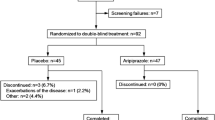Abstract
Forty-six patients (36 male, mean age 11.9 ± 2.6) with a variety of diagnoses and with significant aggressive behavior were treated in an open, non-randomized fashion with Aripiprazole or Ziprasidone. Patients were diagnosed with the Mini International Neuropsychiatric Interview and the Child/Adolescent Symptom Inventory. The primary outcome measure was the Overt Aggression Scale (OAS). After 2 months, 34 patients were still in treatment. The average improvement of the OAS in these 34 patients was 63%. Clinical Global Impression-Improvement Scale was 2.1 ± 1.2. Neither at baseline, nor at 2 months, were there any statistically significant differences between the Aripiprazole and Ziprasidone groups. Sedation was the most common side effect.
Similar content being viewed by others
References
American Diabetes Association, American Psychiatric Association, American Association of Clinical Endocrinologists, North American Association for the Study of Obesity (2004). Consensus development conference on antipsychotic drugs and obesity and diabetes. Diabetes Care, 27, 596–601.
Barzman, D., Delbello, M. P., Kowatch, R. A., Gernert, B., Fleck, D. E., Pathak, S., et al. (2004). The effectiveness and tolerability of Aripiprazole for pediatric bipolar disorders: A retrospective chart review. Journal of Child and Adolescent Psychopharmacology, 14, 593–600.
Bastiaens, L., & Bastiaens, D. (2005). Pediatric experience with Aripiprazole. New Research Abstracts, 158th Annual Meeting, A.P.A., p. 157.
Bastiaens, L., & Dello Stritto, C. (2004). Validity and reliability of the health and life functioning scale. Scientific Proceedings, 51st Annual Meeting, A.A.C.A.P., p. 108.
Biederman, J., Mick, E., Harpold, T., Hammerness, P., Doyle, R., Aleardi, M., et al. (2006). Open-label study of Aripiprazole in youth with bipolar disorder. New Research Abstracts, 159th Annual Meeting, A.P.A., p. 262.
Biederman, J., McDonnell, M. A., Wozniak, J., Spencer, T., Aleardi, M., Falzone, R., et al. (2005). Aripiprazole in the treatment of pediatric bipolar disorder: A systematic chart review. CNS Spectrums, 10, 141–148.
Buitelaar, J. K., van der Gaag, R. J., Cohen-Kettenis, P., & Melman, C. T. (2001). A randomized, controlled trial of risperidone in the treatment of aggression in hospitalized adolescents with subaverage cognitive abilities. The Journal of Clinical Psychiatry, 62, 239–248.
Coccaro, E., & McNamee, B. (1998). Biology of aggression: Relevance to crime. In: Skodol, A. E. (Ed.), Psychopathology and violent crime (pp. 99–128). Washington, DC: Am Psych Press.
Connor, D. F. (2002). Aggression and antisocial behavior in children and adolescents: Research and treatment. NY: Guilford Publications, Inc.
Dejong, S., Giuliano, A. J., & Frazier, J. A. (2004). Antipsychotic medications. In H. Steiner (Ed.), Handbook of mental health interventions in children and adolescents: An integrated developmental approach. San Francisco, CA: Wiley/Jossey-Bass.
Deutschman, D. A., & Deutschman, D. H. (2005). Efficacy and safety of Ziprasidone in youths with Axis I diagnoses. New Research Abstracts, 158th Annual Meeting, A.P.A., p. 161.
Findling, R. L., McNamara, N. K., Branicky, L. A., Schluchter, M. D., Lemon, E., & Blumer, J. L. (2000). A double-blind pilot study of risperidone in the treatment of conduct disorder. Journal of the American Academy of Child and Adolescent Psychiatry, 39, 509–516.
Gadow, K. D., & Sprafkin, J. (1997). Adolescent symptom inventory (vol. 4). Stony Brook, NY: Checkmate Plus Ltd.
Gracious, B. L., & Findling, R. L. (2001). Antipsychotic medications for children and adolescents. Pediatric Annals, 30, 138–145.
Guy, W. (1976). Early clinical drug evaluation unit (ECDEU) assessment manual for psychopharmacology (pp. 217–222). Bethesda, MD: NIMH Publication.
Marchand, W. R., Clark, S. C., Wirth, L., & Simon, C. (2005). Validity of the parent young mania rating scale in community mental health setting. Psychiatry, 2, 31–35.
Martin, A., Scahill, L., Anderson, G. M., Aman, M., Arnold, L. E., McCracken, J., et al. (2004). Weight and leptin changes among risperidone-treated youths with autism: 6-months prospective data. American Journal of Psychiatry, 161, 1125–1127.
McConville, B. J., & Sorter, M. T. (2004). Treatment challenges and safety considerations for antipsychotic use in children and adolescents with psychoses. Journal of Clinical Psychiatry, 65(Suppl 6), 20–29.
McCracken, J. T., McGough, J., Shah, B., Cronin, P., Hong, D., Aman, M. G., et al., for the Research Units on Pediatric Psychopharmacology Autism Network (2002). Risperidone in children with autism and serious behavioral problems. The New England Journal of Medicine, 347, 314–321.
Patel, N. C., Crismon, M. L., Hoagwood, K., & Jensen, P. S. (2005). Unanswered questions regarding atypical antipsychotic use in aggressive children and adolescents. Journal of Child and Adolescent Psychopharmacology, 15, 270–284.
Patel, N. C., Sanchez, R. J., Johnsrud, M. T., & Crismon, M. L. (2002). Trends in antipsychotic use in a Texas medicaid population of children and adolescents: 1996–2000. Journal of Child and Adolescent Psychopharmacology, 12, 221–229.
Ruths, S., & Steiner, H. (2004). Psychopharmacologic treatment of aggression in children and adolescents. Pediatric Annals, 33, 318–327.
Sallee, F. R., Kurlan, R., & Goetz, C. G. (2000). Ziprasidone treatment of children and adolescents with Tourette’s syndrome: A pilot study. Journal of the American Academy of Child and Adolescent Psychiatry, 39, 292–299.
Sheehan, D. V., Lecrubier, Y., Harnett Sheehan, K., Janav, J., Weiller, E., Keskines, A., et al. (1997). The validity of the Mini International Neuropsychiatric Interview (MINI) according to the SCID-P and its reliability. European Psychiatry, 12, 232–241.
Snyder, R., Turgay, A., Aman, M., Binder, C., Fisman, S., Carroll, A., et al. (2002). Effects of risperidone on conduct and disruptive behavioral disorders in children with subaverage IQs. Journal of the American Academy of Child and Adolescent Psychiatry, 41, 1026–1036.
Yudofsy, S. C., Silver, J. M., & Jackson, W. (1986). The overt aggression scale for the objective rating of verbal and physical aggression. American Journal of Psychiatry, 143, 35–39.
Author information
Authors and Affiliations
Corresponding author
Rights and permissions
About this article
Cite this article
Bastiaens, L. A Non-randomized, Open Study with Aripiprazole and Ziprasidone for the Treatment of Aggressive Behavior in Youth in a Community Clinic. Community Ment Health J 45, 73–77 (2009). https://doi.org/10.1007/s10597-008-9154-7
Received:
Accepted:
Published:
Issue Date:
DOI: https://doi.org/10.1007/s10597-008-9154-7




